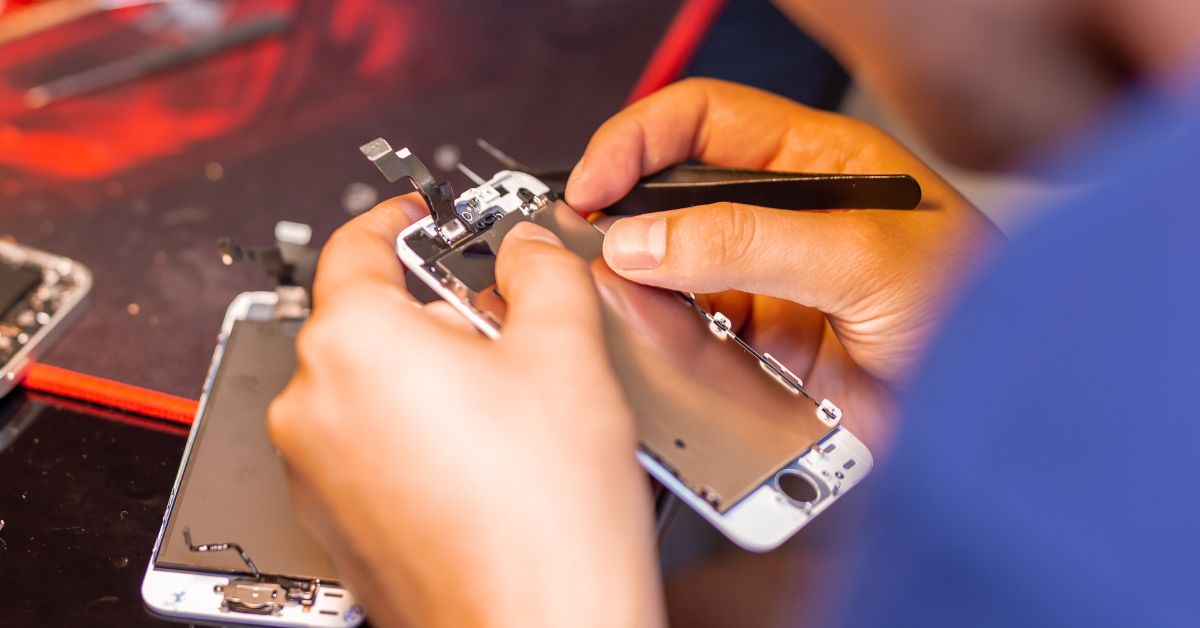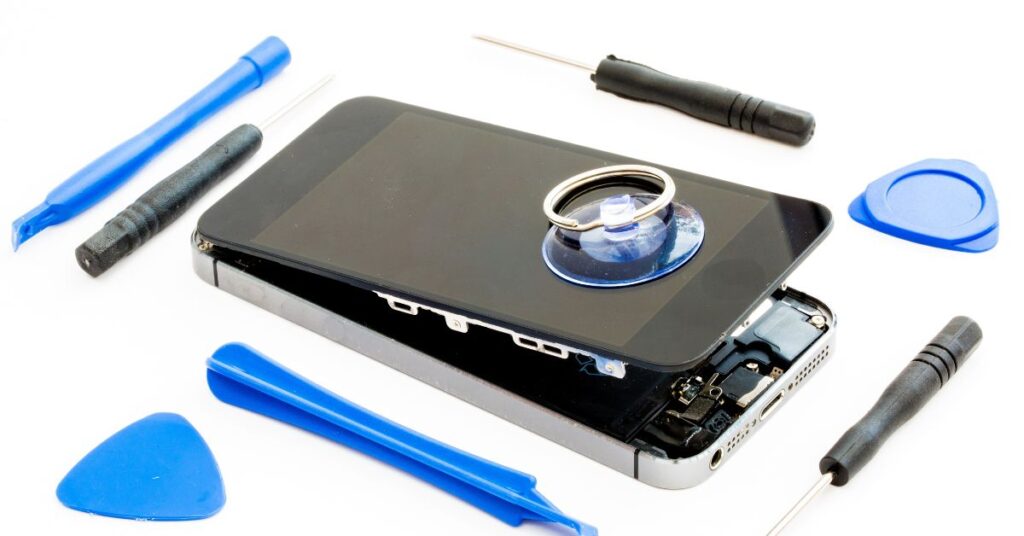The California Right to Repair Law, also known as SB 244, is a landmark legislation that aims to protect consumer rights and promote electronics repair. This law, which will go into effect on July 1, 2024, requires manufacturers to provide documentation, parts, and tools to owners and repair facilities on fair and reasonable terms.
The California Right to Repair Law covers a wide range of electronic and appliance products, including cell phones, laptops, and home appliances. By granting consumers more control over their electronic devices, this legislation fosters a marketplace that promotes sustainable technology.
Key Takeaways
- The California Right to Repair Law empowers consumers by providing them access to the necessary information and resources to repair their electronic devices.
- By promoting electronics repair, this legislation contributes to the reduction of electronic waste and the extension of the lifespan of electronic devices.
- The law covers a wide range of products, including cell phones, laptops, and home appliances.
- Manufacturers are required to make documentation, parts, and tools available on fair and reasonable terms to owners and repair facilities.
- The California Right to Repair Law goes into effect on July 1, 2024.
With the implementation of the California Right to Repair Law, consumers in the state will have more control over their electronic devices and access to reliable repair services. This legislation promotes consumer protection, sustainable technology, and a competitive repair industry, ensuring that electronics repair remains accessible and affordable in California.
Key Provisions of the California Right to Repair Law
The California Right to Repair Law includes several key provisions aimed at protecting consumer rights and reducing electronic waste. These provisions require manufacturers to make documentation, parts, and tools available for a specified period of time and cover a wide range of electronic and appliance products.
Duration of Availability
Under the law, manufacturers are required to make documentation, parts, and tools available for a minimum of three years for products priced between $50 and $99.99. For products priced at $100 or more, the availability period increases to at least seven years. Importantly, these requirements apply regardless of the original warranty period.
Scope of Coverage
The California Right to Repair Law extends its coverage to various contexts where electronic and appliance products are used. This includes products utilized in schools, businesses, local governments, and other settings. By encompassing a wide range of products and usage scenarios, the law aims to protect consumer rights in diverse contexts.
Effective Date and Enforcement
The law applies to products sold or used in California on or after July 1, 2021. Manufacturers who fail to comply with the provisions can face fines, with potential penalties increasing for subsequent violations. By enforcing these regulations, the state aims to ensure that manufacturers uphold their responsibilities to consumers.
| Key Provisions | Duration | Scope | Effective Date and Enforcement |
|---|---|---|---|
| Documentation, Parts, and Tools Availability | At least 3 years for products $50-$99.99 | Various usage contexts | Applies to products sold or used in California on or after July 1, 2021; fines for non-compliance |
| Extended Duration for Higher-Priced Products | At least 7 years for products $100 or more | Penalties increase for subsequent violations |
By implementing these provisions, the California Right to Repair Law aims to empower consumers, reduce electronic waste, and uphold consumer rights in the digital age.
Carveouts and Limitations in the California Right to Repair Law
The California Right to Repair Law includes several carveouts and limitations designed to protect specific industries and manufacturers within the repair and electronics industry.
Firstly, the law does not apply to equipment used in agricultural, forestry, industrial, and construction industries. This exemption ensures that the operation and maintenance of essential machinery and tools in these sectors are not hindered by the requirements of the legislation.
Additionally, video game consoles and alarm systems are excluded from the provisions of the California Right to Repair Law. While these electronics may still require repairs, manufacturers are not obligated to provide documentation, parts, and tools for these specific devices.
Manufacturers are also not required to make available documentation, parts, and tools that would disable anti-theft security measures. This exemption allows manufacturers to protect the security features of their products, preventing unauthorized access or tampering.
Furthermore, manufacturers are not held liable for any damage or injury that may occur during third-party repairs. This limitation protects manufacturers from any potential legal consequences resulting from repairs performed by independent repair facilities.
Lastly, the law safeguards manufacturers’ trade secrets and intellectual property rights. Manufacturers are not obligated to disclose proprietary information or disclose trade secrets as part of the repair process.
While the California Right to Repair Law aims to empower consumers and improve accessibility to repairs, these carveouts and limitations recognize the diverse nature of the repair and electronics industry, respecting the specific needs and considerations of manufacturers and certain industries.
Benefits and Concerns of the California Right to Repair Law
The California Right to Repair Law brings both benefits and concerns in relation to sustainable technology, electronics repair, and electronic devices. By emphasizing accessibility to repairs for consumers and third-party repair shops, the law aims to reduce electronic waste and promote a more sustainable approach to technology.
“The California Right to Repair Law is a significant step towards empowering consumers and extending the lifespan of electronic devices,” says Jessica Green, a technology expert at GreenTech Solutions. “By making repairs more accessible, it encourages a culture of reusing and repairing rather than discarding and replacing.”
With the law in place, consumers have the opportunity to extend the life of their electronic devices, reducing the environmental impact caused by the constant turnover of electronic waste. This not only benefits the planet but also provides potential cost savings to individuals and businesses.
However, concerns have been raised regarding the law’s potential impact on product innovation and the protection of manufacturers’ intellectual property. Critics argue that the requirement for manufacturers to disclose the use of nongenuine or used parts in repairs could potentially limit innovation and hinder the development of new technologies.
In response to these concerns, the law includes provisions that allow manufacturers to provide equivalent or better replacement products to consumers. This ensures that repairs are performed using high-quality components that meet the original specifications, maintaining the overall performance and functionality of the electronic devices.
Overall, the California Right to Repair Law strikes a balance between promoting sustainable technology and protecting the interests of manufacturers. By empowering consumers and third-party repair shops, the law encourages a thriving repair industry that contributes to a more sustainable future.
| Benefits of the California Right to Repair Law | Concerns of the California Right to Repair Law |
|---|---|
| Reduces electronic wastePromotes a more sustainable approach to technologyProvides cost savings for consumers and businessesEmpowers consumers to extend the lifespan of their electronic devices | Potential impact on product innovationPossible limitations on manufacturers’ intellectual property rightsDisclosure requirements may limit the development of new technologies |
Right to Repair Laws in Other States
The California Right to Repair Law is part of a broader movement towards right to repair legislation in the United States. Several other states have also introduced right-to-repair bills to address consumer rights and electronic waste. Let’s take a closer look at the progress in some of these states:
Delaware
Delaware has introduced a comprehensive right to repair bill that covers electronic devices, appliances, and even motor vehicles. The proposed legislation aims to provide consumers with the means to repair their products independently or through third-party repair shops, reducing electronic waste and promoting local repair businesses.
Hawaii
Hawaii is another state that recognizes the importance of empowering consumers and reducing electronic waste through right to repair legislation. The proposed bill in Hawaii focuses on ensuring manufacturers provide repair information, parts, and tools to consumers and independent repair technicians, fostering a competitive and sustainable repair industry.
Massachusetts
Massachusetts is at the forefront of the right to repair movement with its existing Massachusetts Right to Repair law, which was passed in 2012 for the automotive industry. In 2020, the state expanded the law to include electronic devices, granting consumers access to repair information and parts. Massachusetts’ proactive approach serves as a model for other states.
Oregon
Oregon, known for its sustainability efforts, has also joined the right to repair movement. The state’s proposed legislation aims to make diagnostic and repair information available to consumers and independent repair providers for a wide range of electronic devices. By empowering consumers with the right to repair, Oregon aims to reduce electronic waste and promote a circular economy.
These states are just a few examples of the growing recognition of the importance of right to repair legislation in addressing consumer rights and electronic waste. With more states joining the movement, consumers are gaining greater control over the repair of their electronic devices, and the repair industry is becoming more competitive and sustainable.
| State | Year of Right to Repair Legislation |
|---|---|
| Delaware | 2023 |
| Hawaii | 2024 |
| Massachusetts | 2012 (automotive industry) 2020 (electronic devices) |
| Oregon | 2022 (proposed) |
Table: Right to Repair Legislation in Other States
Conclusion
The California Right to Repair Law represents a significant milestone in the electronics and repair industry, with a focus on protecting consumer rights and promoting sustainable technology. This legislation ensures that manufacturers are obligated to provide consumers with the necessary documentation, parts, and tools for repairing their electronic devices. By doing so, the law empowers consumers to have more control over their electronic devices, reducing the need for premature replacement and ultimately contributing to a decrease in electronic waste.
While concerns have been raised about the potential impact on product innovation and intellectual property rights, it is important to acknowledge the law’s primary objective of empowering consumers and fostering a competitive repair industry. By advocating for consumer rights and promoting access to repair services, California is leading the way towards a more sustainable and consumer-friendly electronics landscape.
The California Right to Repair Law is part of a wider movement that is gaining momentum across different states in the United States. As more states introduce right to repair legislation, it is evident that there is a growing recognition of the need to address consumer rights and electronic waste. This movement signifies a shift towards a more consumer-centric approach and a desire to promote sustainable practices within the electronics industry.
With the implementation of the California Right to Repair Law, consumers can confidently seek repairs for their electronic devices, extending their lifespan and reducing unnecessary waste. The law serves as a reminder that consumers have the right to choose how they maintain and repair their electronic possessions. Ultimately, this legislation promotes a more sustainable future by encouraging responsible consumption and providing consumers with the tools and resources necessary to repair their electronic devices.
FAQ
What is the California Right to Repair Law?
The California Right to Repair Law is a legislation that requires manufacturers to provide documentation, parts, and tools to owners and repair facilities for electronic and appliance products on fair and reasonable terms.
When does the California Right to Repair Law go into effect?
The California Right to Repair Law goes into effect on July 1, 2024.
Which products are covered by the California Right to Repair Law?
The California Right to Repair Law covers a wide range of electronic and appliance products, including cell phones, laptops, and home appliances.
How long are manufacturers required to make documentation, parts, and tools available?
Manufacturers are required to make documentation, parts, and tools available for at least three years for products priced between $50 and $99.99, and for at least seven years for products priced at $100 or more, regardless of warranty periods.
Are there any limitations to the California Right to Repair Law?
Yes, the law does not apply to equipment used in agricultural, forestry, industrial, and construction industries. It also excludes video game consoles and alarm systems from the requirements.
What are the benefits of the California Right to Repair Law?
The California Right to Repair Law aims to reduce electronic waste by making repairs more accessible to consumers and third-party repair shops. It also promotes sustainable technology by extending the lifespan of electronic devices.
What are the concerns associated with the California Right to Repair Law?
Concerns have been raised about the potential impact on product innovation and the protection of manufacturers’ intellectual property. The law requires manufacturers to disclose the use of nongenuine or used parts in repairs and allows for equivalent or better replacement products to be provided to consumers.
Are there similar right to repair laws in other states?
Yes, other states, including Delaware, Hawaii, Massachusetts, Oregon, and more, have also introduced right-to-repair bills to give consumers more control over the repair of their electronic devices and promote a competitive and sustainable repair industry.
What does the California Right to Repair Law aim to accomplish?
The California Right to Repair Law aims to protect consumer rights in the electronics industry and promote sustainable technology by ensuring that manufacturers provide documentation, parts, and tools for repairs.








